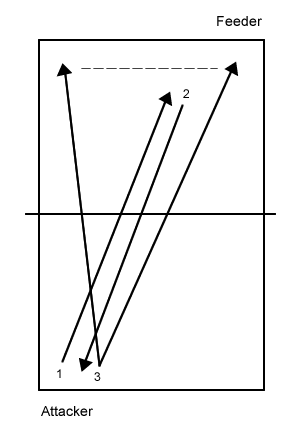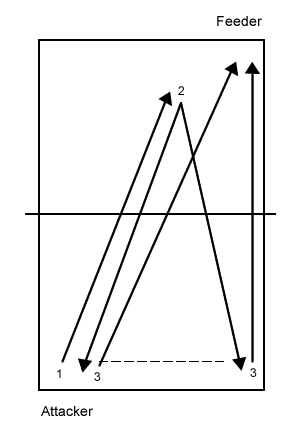You can win lots of points with strong 3rd ball attacks. You serve, your opponent returns, you attack. If all goes to plan, you win the point on the third ball. Even if you don’t win the point on the third ball, you are likely to be in control of the rally.
To be a strong 3rd ball attacker you need to practice lots of different serve and receive routines. The key is to always expect your serve to be returned and anticipate the most likely places where the ball will be returned. You will then be in a good position to play a strong 3rd ball attack.
In this blog post I share a few 3rd ball attack training drills. This is by no means a complete list, but will hopefully give you a few ideas to get started.
Each drill below includes a diagram, step-by-step instructions and suggestions for making the drill harder. The drills assume it’s a right-handed player vs a right-handed player, but they are easy to amend for a righty playing a lefty, or a lefty playing a lefty.
3rd ball attack training drills
Forehand flick
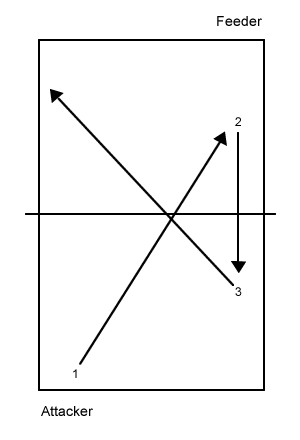
This is a good drill to practice your forehand flick, which is one of the tougher shots to play in table tennis. Often players will push a short ball to their forehand. There is nothing wrong with pushing these balls, but if you can learn to flick too, then you will have another option to put your opponent under pressure
- 1st ball: The attacker serves short backspin to the feeder’s backhand.
- 2nd ball: The feeder pushes short to the attacker’s forehand.
- 3rd ball: The attacker plays a forehand flick wide to the feeder’s forehand. If the ball is returned, play out the point.
To make it harder:
- The feeder pushes with more backspin (2nd ball).
To make it irregular:
- The feeder pushes to any position on the attacker’s forehand side of the table (2nd ball).
- The attacker flicks to any position on the table (3rd ball)
Backhand flick or backhand topspin
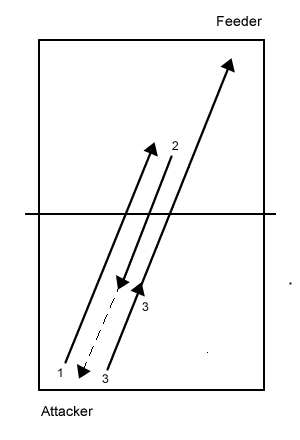
This drill will help you practice attacking both short and long backspin balls with your backhand. If short, you should flick. If long, you should open up with a bigger topspin stroke. Both of these shots require different technique and timing, so you need to play the correct stroke, depending on whether your opponent’s push is long or short. If you can master both, you will be able to attack any backspin ball played towards your backhand.
- 1st ball: The attacker serves short backspin to the centre of the table.
- 2nd ball: The feeder either pushes short or long to the attacker’s backhand.
- 3rd ball: If the push is short, the attacker plays a backhand flick. If the ball is long, the attacker plays a backhand topspin. If the ball is returned, play out the point.
To make it harder:
- The feeder varies the speed and spin of the push (2nd ball).
To make it irregular:
- The feeder pushes to any position on the attacker’s backhand side of the table (2nd ball).
Topspin to cross-over
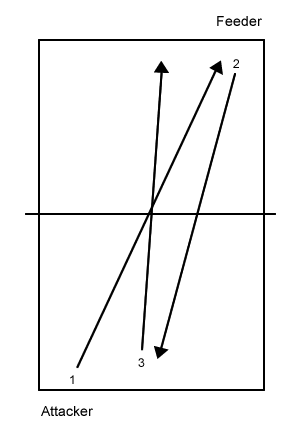
You can win lots of points by attacking your opponent’s crossover point (i.e. aiming for their playing elbow). Too often players focus on attacking the corners and forget about attacking the crossover point. Why is attacking the crossover so effective? Because you force your opponent to make a decision. Do they try and block back with their backhand or forehand? If you attack with speed, you reduce the time they have to make this decision and they will often make an error.
- 1st ball: The attacker serves long topspin to the feeder’s backhand.
- 2nd ball: The feeder plays a medium speed backhand topspin to the middle of the table.
- 3rd ball: The attacker plays a forehand topspin to the feeder’s playing elbow (cross-over point). If the ball is returned, play out the point.
To make it harder:
- The feeder plays a faster backhand topspin (2nd ball).
To make it irregular:
- The feeder topspins to any position on the table (2nd ball). The attacker can play a forehand or backhand 3rd ball attack, but must aim for the feeder’s playing elbow (3rd ball).
Forehand set-up
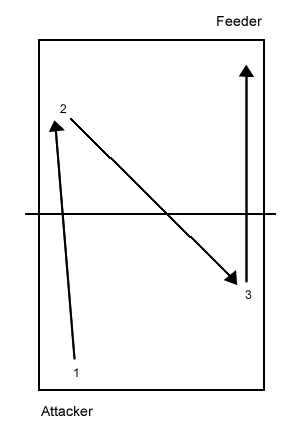
A reverse sidespin serve to an opponent’s forehand can be a great way to set up a forehand attack. The key is to get plenty of sidespin on the serve. This will help the ball spin off your opponent’s bat towards your forehand. You do need to practice this serve a lot before it becomes really effective. But it’s worth persevering if you like attacking with your forehand, as this serve will set up lots of easy balls for you to attack.
- 1st ball: The attacker serves reverse sidespin to the feeder’s forehand.
- 2nd ball: The feeder blocks the ball back to the attacker’s forehand side of the table.
- 3rd ball: The attacker plays a forehand topspin down the line. If the ball is returned, play out the point.
To make it harder:
- The feeder blocks the ball back faster or plays a medium speed topspin (2nd ball)
To make it irregular:
- The feeder returns the ball to wide forehand, middle forehand or centre of the table (2nd ball).
- The attacker topspins to any position on the table (3rd ball).
Short, wide serve
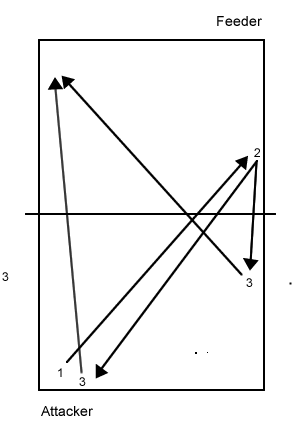
A short, wide serve can be an effective way to catch out an opponent. The serve is typically return in one of two ways. If your opponent doesn’t read the serve, they will lunge for the ball and send it straight back to you. Or if your opponent does read the serve, the may touch it back over the net, forcing you to move across the table to play an attack. This drill will help your practice both types of return.
- 1st ball: The attacker serves very wide to the feeder’s backhand.
- 2nd ball: The feeder returns either short to the attacker’s forehand or long to the attacker’s backhand.
- 3rd ball: If the ball is returned short, the attacker should play a forehand flick crosscourt. If the ball is returned long, the attacker should play a backhand topspin down the line. If the ball is returned, play out the point.
To make it harder:
- The feeder returns either very short (just over the net) or very long (close to the baseline) (2nd ball).
To make it irregular:
- The feeder can return to four positions. (1) Short to the forehand. (2). Short to the backhand. (3) Long to the forehand. (4) Long to the backhand. (2nd ball).
- The attacker can attack to any position on the table (3rd ball)
Topspin or backspin receive
This is a good drill for playing different types of topspin attack. If your opponent pushes your serve, you should start with your bat lower, finish higher and brush the back of the ball to lift the backspin over the net. If your opponent topspins your serve, you should start with your bat higher and play more forward, brushing the top of the ball. If you play the wrong shot against the wrong spin, you’ll make an error.
- 1st ball: The attacker serves half-long backspin or side-backspin to the middle of the table.
- 2nd ball: The feeder either pushes or plays a medium speed topspin to the attacker’s backhand.
- 3rd ball. The attacker plays backhand topspin vs backspin or backhand topspin vs topspin depending on how the feeder returns the ball. The attacker can topspin to any position on the table. If the ball is returned, play out the point.
To make it harder:
- The feeder adds more backspin to the push, or plays a faster topspin (2nd ball).
To make it irregular:
- The feeder returns the ball to any position on the table (2nd ball). Now the attacker can play backhand or forehand topspins.
Random receive
A good receiver will make your life difficult. They will return your serves with different spins to different positions. When you don’t know where your opponent will return your serve, you can become hesitant, which can lead to errors. But with a bit of practice you can quickly get much better at dealing with random return of serves. Make sure you watch your opponents arm/wrist movement, bat angle, bat finishing point and type of contact. These will give you clues as to where the ball will be returned and then you can make a strong 3rd ball attack.
- 1st ball: The attacker serves half-long sidespin to the middle of the table.
- 2nd ball: The feeder blocks the ball to any position on the table.
- 3rd ball: The attacker plays a forehand or backhand topspin to the feeder’s backhand corner. If the ball is returned, play out the point.
To make it harder:
- The feeder returns the ball with more speed (2nd ball)
To make it irregular:
- The feeder varies how they return the serve – they can block, push or topspin (2nd ball)
- The attacker can topspin to any position on the table (3rd ball)
Training drill library
If you would like some training drill ideas, I recommend you join Tom’s TT Academy. In my online academy, you will get access to my training drill library. Every training drill includes a video demonstration, plus technical tips and ideas to make the drill easier or harder.
When you join my academy, you will also get access to a wide range of coaching content, including:
- in-depth courses
- video analysis
- fitness videos
- robot training videos
- member discussions
- skill challenges
- and lot’s more!
You can access all this content for less than £1 per week. New content is added regularly. Join hundreds of table tennis players around the world today at tomsttacademy.com

